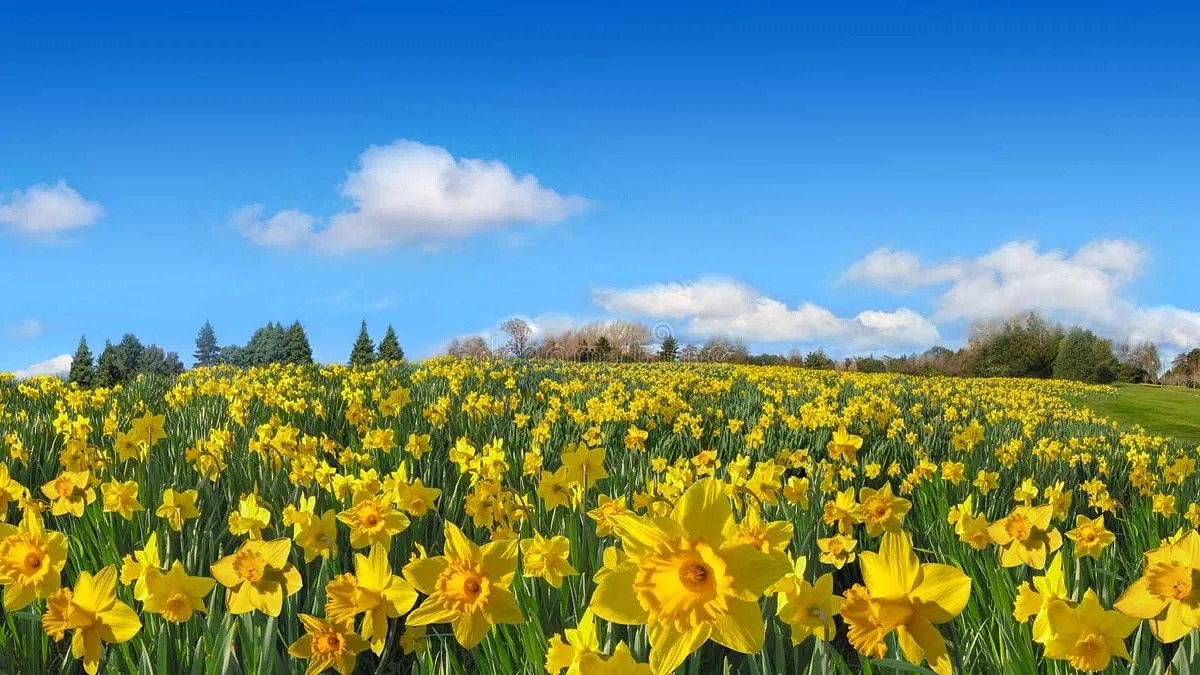Fluttering and dancing 'Daffodils' in the breeze
Daffodils are a clear sign that spring has arrived in the UK and most of Europe. Often found in gardens and parks all over the country. They are native to Europe and are grown as ornamental plants all over the world. It's a single flower on a long green stalk with green leaves growing from the bottom of the stalk. People recognise them by the bright yellow or white petals that surround a trumpet-shaped petal. Most of the time, the flowers face down, but sometimes they face up. These come from bulbs that go to sleep from summer to late winter. They grow from bulbs and usually bloom in early to mid-spring, from February to May, depending on the climate and the type being grown.
Daffodils of all sizes and shapes have been seen in England since the 17th century; Shakespeare celebrated them as the flower that “comes before the swallow dares”, and bunches of wild blooms were sold by flower girls on the streets of London. However, the farming of daffodils for cut-flower sales did not start until the late 19th century.Daffodils are usually bright yellow, but they also come in white, pink, and orange, among other colours. One surprising thing about daffodil flowers is that they can handle medium snowfalls that come out of nowhere.

Narcissus is the scientific name for daffodils. It's a perennial plant, which means that it grows back each spring. Most perennials bloom for a shorter amount of time than annuals. Annual plants only grow for one season and then die.
Even though they bloom around February, when the weather is still cold, daffodils are one of the most loved spring flowers. No matter where the yellow petals grow, they are beautiful when they are at their best. Once you plant daffodils, they will grow back every year and even make more of themselves.
Near Easter, the beautiful daffodils will be in full bloom. Daffodils are a sign that new life is coming. In England, they are called "Lent lilies" because they have been linked to Lent for a long time. So, at Easter, people give a bunch of daffodils as a gift.
Both the flower and the bulb of daffodils are poisonous, even though they look pretty. If animals or people eat it, it can cause nausea, vomiting, diarrhoea, a faster heart rate, abdominal pain, breathing problems, and irregular heartbeats.
William Wordsworth, an English poet, wrote a well-known poem called "Daffodils" in 1802. In Britain, a poll done by BBC Radio 4 in 1995 said that it was one of the country's favourite poems. In 1815, Wordsworth changed his poem about daffodils. He changed the words "dancing" with "golden", "along" with "beside" and "ten thousand" to "fluttering. He added a stanza between the first and second and changed "laughing" to "jocund." The last line was not changed.
"I wandered lonely as a cloud
That floats on high o'er vales and hills,
When all at once I saw a crowd,
A host of golden daffodils;
Beside the lake, beneath the trees,
Fluttering and dancing in the breeze.
Continuous as the stars that shine
and twinkle on the Milky Way,
They stretched in never-ending line
along the margin of a bay:
Ten thousand saw I at a glance,
tossing their heads in sprightly dance.
The waves beside them danced; but they
Out-did the sparkling waves in glee:
A poet could not but be gay,
in such a jocund company:
I gazed—and gazed—but little thought
what wealth the show to me had brought:
For oft, when on my couch I lie
In vacant or in pensive mood,
They flash upon that inward eye
Which is the bliss of solitude;
And then my heart with pleasure fills,
And dances with the daffodils."